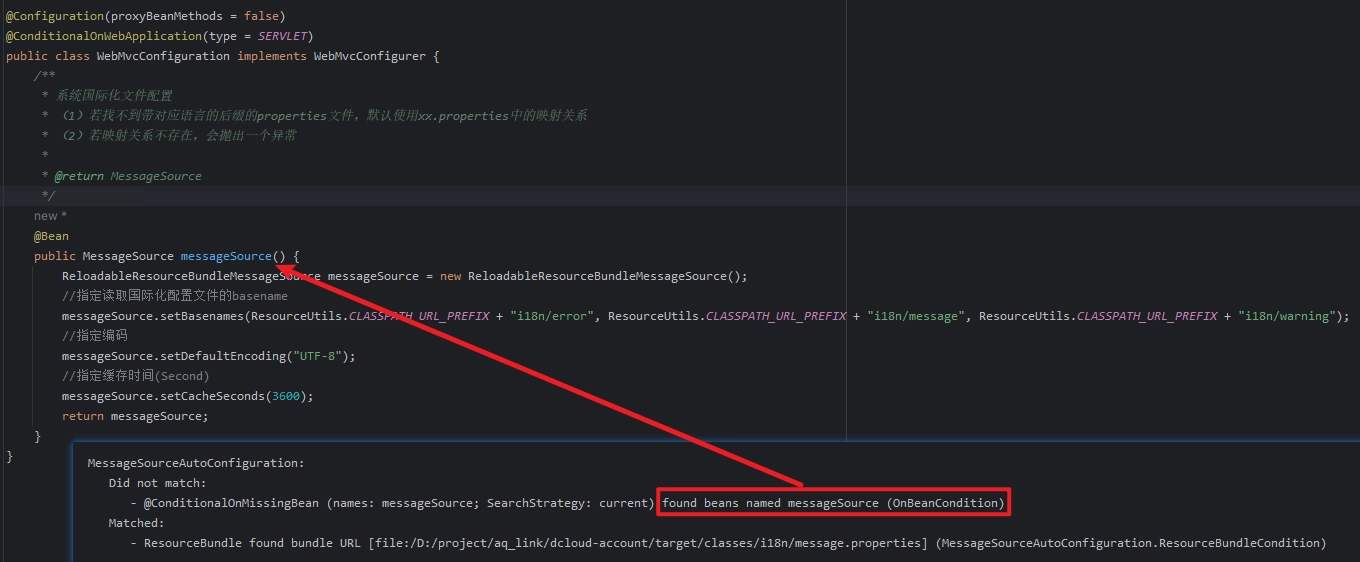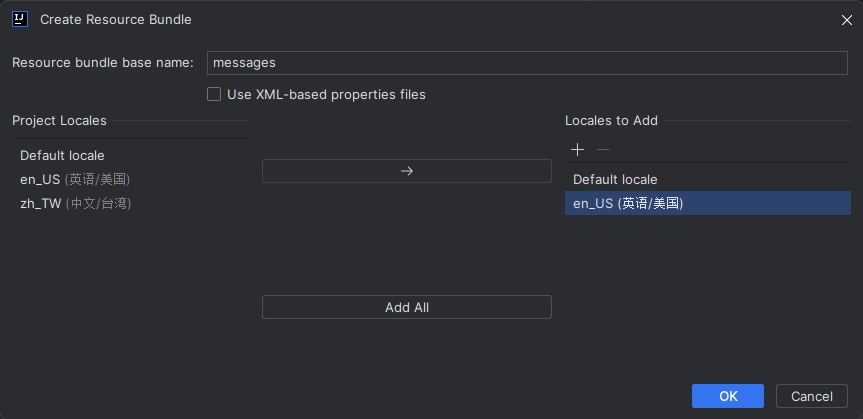配置类封装-国际化MessageSource
# 引言
国际化的自动配置参照
MessageSourceAutoConfiguration,在springboot项目中实现国际化主要分为以下几步:
- 添加国际化资源文件 resource(都是放在静态资源的文件夹里面,这没什么好说的,主要遵循格式就好)
- 配置messageResource 设置国际化资源文件(覆盖spring自动配置的文件)
- 需要去解析请求头中的accept-language 或者 解析url参数中?local=(这里可以修改读取指定字段)
- 随意切换本地语言,进行缓存(下面都是一些 api 层面的东西)
- 通过messageResource 获取国际化信息
- Spring Boot 在类路径根下查找messages资源绑定文件。文件名为:
messages.properties - 多语言可以定义多个消息文件,命名为
messages_区域代码.properties。如:messages.properties:默认messages_zh_CN.properties:中文环境messages_en_US.properties:英语环境
- 在程序中可以自动注入
MessageSource组件,获取国际化的配置项值
@Autowired //国际化取消息用的组件
MessageSource messageSource;
@GetMapping("/haha")
public String haha(HttpServletRequest request){
//利用代码的方式获取国际化配置文件中指定的配置项的值
return messageSource.getMessage("login", null, request.getLocale());
}
1
2
3
4
5
6
7
2
3
4
5
6
7
# 引包
<!-- springboot 基础包 -->
<dependency>
<groupId>org.springframework.boot</groupId>
<artifactId>spring-boot-starter</artifactId>
</dependency>
<!-- springboot web包 -->
<dependency>
<groupId>org.springframework.boot</groupId>
<artifactId>spring-boot-starter-web</artifactId>
</dependency>
1
2
3
4
5
6
7
8
9
10
2
3
4
5
6
7
8
9
10
# 标准模板
# 覆盖messageSource同名Bean
import org.springframework.boot.autoconfigure.condition.ConditionalOnWebApplication;
import org.springframework.context.MessageSource;
import org.springframework.context.annotation.Bean;
import org.springframework.context.annotation.Configuration;
import org.springframework.context.support.ReloadableResourceBundleMessageSource;
import org.springframework.util.ResourceUtils;
import org.springframework.web.servlet.config.annotation.WebMvcConfigurer;
import static org.springframework.boot.autoconfigure.condition.ConditionalOnWebApplication.Type.SERVLET;
@Configuration(proxyBeanMethods = false)
@ConditionalOnWebApplication(type = SERVLET)
public class WebMvcConfiguration implements WebMvcConfigurer {
@Override
public void addInterceptors(InterceptorRegistry registry) {
registry.addInterceptor(localeChangeInterceptor());
}
/**
* 语言环境切换拦截器
*
* @return
*/
@Bean
public LocaleChangeInterceptor localeChangeInterceptor() {
LocaleChangeInterceptor interceptor = new LocaleChangeInterceptor();
// 设置拦截请求url上参数的key,不设置,默认值"locale"
interceptor.setParamName("lang");
return interceptor;
}
/**
* 自定义语言解析器,覆盖默认的AcceptHeaderLocaleResolver
* tips:返回类型必须声明为LocaleResolver 接口类型,不然不会替换掉默认的AcceptHeaderLocaleResolver
*
* @return
*/
@Bean
public LocaleResolver localeResolver() {
SessionLocaleResolver localeResolver = new SessionLocaleResolver();
localeResolver.setDefaultLocale(Locale.CHINA); // 设置默认语言环境"中文"
return localeResolver;
}
/**
* 系统国际化文件配置
* (1)若找不到带对应语言的后缀的properties文件,默认使用xx.properties中的映射关系
* (2)若映射关系不存在,会抛出一个异常
*
* @return MessageSource
*/
@Bean
public MessageSource messageSource() {
ReloadableResourceBundleMessageSource messageSource = new ReloadableResourceBundleMessageSource();
//指定读取国际化配置文件的basename
messageSource.setBasenames(ResourceUtils.CLASSPATH_URL_PREFIX + "i18n/error", ResourceUtils.CLASSPATH_URL_PREFIX + "i18n/message");
//指定编码
messageSource.setDefaultEncoding("UTF-8");
//指定缓存时间(Second)
messageSource.setCacheSeconds(3600);
return messageSource;
}
}
1
2
3
4
5
6
7
8
9
10
11
12
13
14
15
16
17
18
19
20
21
22
23
24
25
26
27
28
29
30
31
32
33
34
35
36
37
38
39
40
41
42
43
44
45
46
47
48
49
50
51
52
53
54
55
56
57
58
59
60
61
62
63
2
3
4
5
6
7
8
9
10
11
12
13
14
15
16
17
18
19
20
21
22
23
24
25
26
27
28
29
30
31
32
33
34
35
36
37
38
39
40
41
42
43
44
45
46
47
48
49
50
51
52
53
54
55
56
57
58
59
60
61
62
63
# 自定义WebMvcConfigurer类
# 自定义MessageSource
@Configuration(proxyBeanMethods = false)注解的作用主要是控制是否使用CGLIB代理来代理@Bean方法。
- 当
proxyBeanMethods设置为true时,被@Bean标识的方法会被 CGLIB 代理,同时也会遵循 Spring 容器的一些生命周期行为,比如@PostConstruct和@Destroy。如果这些@Bean方法返回的是单例 Bean,那么在同一个配置类中多次调用这些方法,得到的都是同一个 Bean 实例,因为该 Bean 只会被初始化一次。- 当
proxyBeanMethods设置为false时,被@Bean标识的方法不会被拦截以进行 CGLIB 代理,也不会遵循 Spring 容器中的生命周期行为。在同一个配置类中调用@Bean标识的方法时,仅仅是普通方法的执行,不会从容器中获取对象。即使单独调用@Bean标识的方法,也仅仅是普通方法调用,不会走 Bean 的生命周期。
import org.springframework.boot.autoconfigure.condition.ConditionalOnWebApplication;
import org.springframework.context.MessageSource;
import org.springframework.context.annotation.Bean;
import org.springframework.context.annotation.Configuration;
import org.springframework.context.support.ReloadableResourceBundleMessageSource;
import org.springframework.util.ResourceUtils;
import org.springframework.web.servlet.config.annotation.WebMvcConfigurer;
import static org.springframework.boot.autoconfigure.condition.ConditionalOnWebApplication.Type.SERVLET;
@Configuration(proxyBeanMethods = false)
@ConditionalOnWebApplication(type = SERVLET)
public class WebMvcConfiguration implements WebMvcConfigurer {
/**
* 系统国际化文件配置
* (1)若找不到带对应语言的后缀的properties文件,默认使用xx.properties中的映射关系
* (2)若映射关系不存在,会抛出一个异常
*
* @return MessageSource
*/
@Bean("messageSource")
public MessageSource messageSource() {
ReloadableResourceBundleMessageSource messageSource = new ReloadableResourceBundleMessageSource();
//指定读取国际化配置文件的basename
messageSource.setBasenames(ResourceUtils.CLASSPATH_URL_PREFIX + "i18n/error", ResourceUtils.CLASSPATH_URL_PREFIX + "i18n/message");
//指定编码
messageSource.setDefaultEncoding("UTF-8");
//指定缓存时间(Second)
messageSource.setCacheSeconds(3600);
return messageSource;
}
}
1
2
3
4
5
6
7
8
9
10
11
12
13
14
15
16
17
18
19
20
21
22
23
24
25
26
27
28
29
30
31
32
2
3
4
5
6
7
8
9
10
11
12
13
14
15
16
17
18
19
20
21
22
23
24
25
26
27
28
29
30
31
32
- 热加载机制
ReloadableResourceBundleMessageSource是支持资源文件热加载的。配置的国际化资源文件的变化将会在下一次请求时被重新加载,可以实现动态更新国际化资源而不需要重启应用程序。ReloadableResourceBundleMessageSource在重新加载资源文件时,会替换已有的缓存内容。当检测到资源文件已经被修改并重新加载成功后,它会更新内部的缓存,包括之前已经加载的内容。因此,如果在获取key2时发现时间有变化并重新加载成功,它会更新缓存中的所有内容,包括key1,以确保缓存中的内容是最新的。
# 简单写法(不支持热加载)
在配置文件中写,具体原因在源码解析里面会有
spring:
messages:
basename: i18n/error,i18n/message
encoding: UTF-8
cache-seconds: 3600
1
2
3
4
5
2
3
4
5
# 自定义国际化语言拦截器
@Configuration
public class WebConfig implements WebMvcConfigurer {
@Override
public void addInterceptors(InterceptorRegistry registry) {
registry.addInterceptor(localeChangeInterceptor());
}
/**
* 语言环境切换拦截器
*
* @return
*/
@Bean
public LocaleChangeInterceptor localeChangeInterceptor() {
LocaleChangeInterceptor interceptor = new LocaleChangeInterceptor();
// 设置拦截请求url上参数的key,不设置,默认值"locale"
interceptor.setParamName("lang");
return interceptor;
}
/**
* 自定义语言解析器,覆盖默认的AcceptHeaderLocaleResolver
* tips:返回类型必须声明为LocaleResolver 接口类型,不然不会替换掉默认的AcceptHeaderLocaleResolver
*
* @return
*/
@Bean
public LocaleResolver localeResolver() {
SessionLocaleResolver localeResolver = new SessionLocaleResolver();
// 设置默认语言环境"中文"
localeResolver.setDefaultLocale(Locale.CHINA);
return localeResolver;
}
}
1
2
3
4
5
6
7
8
9
10
11
12
13
14
15
16
17
18
19
20
21
22
23
24
25
26
27
28
29
30
31
32
33
34
2
3
4
5
6
7
8
9
10
11
12
13
14
15
16
17
18
19
20
21
22
23
24
25
26
27
28
29
30
31
32
33
34
- localeResolver是bean的名称
# 国际化Util封装
import org.springframework.context.MessageSource;
import org.springframework.context.i18n.LocaleContextHolder;
import org.springframework.stereotype.Component;
import lombok.RequiredArgsConstructor;
import lombok.extern.slf4j.Slf4j;
import java.util.Locale;
/**
* 获取国际化消息的翻译工具类。
*/
@Component
@Slf4j
@RequiredArgsConstructor
public class TranslationUtil {
private final MessageSource messageSource;
/**
* 获取国际化消息。
*
* @param code 消息码
* @param param 参数
* @return 国际化消息
*/
public String getMessage(String code, Object... param) {
return getMessage(code, LocaleContextHolder.getLocale(), param);
}
/**
* 获取特定区域设置下的国际化消息。
*
* @param code 消息码
* @param locale 区域
* @param param 参数
* @return 国际化消息
*/
public String getMessage(String code, Locale locale, Object... param) {
try {
return messageSource.getMessage(code, param, locale);
} catch (Exception e) {
log.error("国际化错误: {}", e.getMessage(), e);
}
return "";
}
/**
* 获取 MyExceptionInfoEnum 的国际化消息。
*
* @param infoEnum 异常信息
* @param param 参数
* @return 国际化异常消息
*/
public String getMessage(MyExceptionInfoEnum infoEnum, Object... param) {
return getMessage(infoEnum.getCode(), param);
}
}
1
2
3
4
5
6
7
8
9
10
11
12
13
14
15
16
17
18
19
20
21
22
23
24
25
26
27
28
29
30
31
32
33
34
35
36
37
38
39
40
41
42
43
44
45
46
47
48
49
50
51
52
53
54
55
56
57
2
3
4
5
6
7
8
9
10
11
12
13
14
15
16
17
18
19
20
21
22
23
24
25
26
27
28
29
30
31
32
33
34
35
36
37
38
39
40
41
42
43
44
45
46
47
48
49
50
51
52
53
54
55
56
57
- 尽管
Locale类型也是Object的子类,但是由于方法参数列表中包含了不同的参数类型(Object...和Locale)
# 源码
# 实现
@AutoConfiguration
@ConditionalOnMissingBean(name = AbstractApplicationContext.MESSAGE_SOURCE_BEAN_NAME, search = SearchStrategy.CURRENT)
@AutoConfigureOrder(Ordered.HIGHEST_PRECEDENCE)
@Conditional(ResourceBundleCondition.class)
@EnableConfigurationProperties
public class MessageSourceAutoConfiguration {
private static final Resource[] NO_RESOURCES = {};
@Bean
@ConfigurationProperties(prefix = "spring.messages")
public MessageSourceProperties messageSourceProperties() {
return new MessageSourceProperties();
}
@Bean
public MessageSource messageSource(MessageSourceProperties properties) {
ResourceBundleMessageSource messageSource = new ResourceBundleMessageSource();
if (StringUtils.hasText(properties.getBasename())) {
messageSource.setBasenames(StringUtils
.commaDelimitedListToStringArray(StringUtils.trimAllWhitespace(properties.getBasename())));
}
if (properties.getEncoding() != null) {
messageSource.setDefaultEncoding(properties.getEncoding().name());
}
messageSource.setFallbackToSystemLocale(properties.isFallbackToSystemLocale());
Duration cacheDuration = properties.getCacheDuration();
if (cacheDuration != null) {
messageSource.setCacheMillis(cacheDuration.toMillis());
}
messageSource.setAlwaysUseMessageFormat(properties.isAlwaysUseMessageFormat());
messageSource.setUseCodeAsDefaultMessage(properties.isUseCodeAsDefaultMessage());
return messageSource;
}
protected static class ResourceBundleCondition extends SpringBootCondition {
// 省略了
}
}
1
2
3
4
5
6
7
8
9
10
11
12
13
14
15
16
17
18
19
20
21
22
23
24
25
26
27
28
29
30
31
32
33
34
35
36
37
38
39
40
41
42
2
3
4
5
6
7
8
9
10
11
12
13
14
15
16
17
18
19
20
21
22
23
24
25
26
27
28
29
30
31
32
33
34
35
36
37
38
39
40
41
42
- 这是一个自动注入类
- @ConditionalOnMissingBean:如果容器中不存在这个Bean(组件),则触发指定行为
# 注解
@ConditionalOnMissingBean(name = AbstractApplicationContext.MESSAGE_SOURCE_BEAN_NAME, search = SearchStrategy.CURRENT)- 这里注意要用正确的写法!不能把beanName乱写
@Conditional(ResourceBundleCondition.class):找到就能够添加自动注入类,找不到就不行去
application.yml里面找配置:messages: basename: i18n/message1
2
# MessageSourceProperties
basename:指定消息资源文件的基本名称,可以是一个逗号分隔的字符串,用于指定多个资源文件。它遵循 ResourceBundle 的约定,支持相对类路径或绝对路径。如果不包含包限定符(例如"org.mypackage"),则将从类路径根目录解析。encoding:指定消息资源文件的编码方式,默认为 UTF-8。cacheDuration:加载的资源包文件缓存持续时间。如果未设置,资源包将永远被缓存。如果未指定持续时间后缀,则默认使用秒。fallbackToSystemLocale:指定是否在没有找到特定语言环境的文件时,是否回退到系统默认语言环境。如果设置为 false,则只会回退到默认文件(例如,对于基本名称为 "messages",将会回退到 "messages.properties")。alwaysUseMessageFormat:指定是否总是应用 MessageFormat 规则,即使消息没有参数也会进行解析。useCodeAsDefaultMessage:指定是否将消息代码用作默认消息,而不是抛出 "NoSuchMessageException"。建议仅在开发阶段使用。
# @Conditional(ResourceBundleCondition.class)
如果最后判断完之后发现没有文件,那么就不满足条件,不会自动加载messageSource类
private static ConcurrentReferenceHashMap<String, ConditionOutcome> cache = new ConcurrentReferenceHashMap<>();
@Override
public ConditionOutcome getMatchOutcome(ConditionContext context, AnnotatedTypeMetadata metadata) {
// 1、有配置:默认检查一下配置文件里面有没有指定路径(配置优先)
// 2、没有配置:默认baseName为messages
String basename = context.getEnvironment().getProperty("spring.messages.basename", "messages");
ConditionOutcome outcome = cache.get(basename);
if (outcome == null) {
outcome = getMatchOutcomeForBasename(context, basename);
cache.put(basename, outcome);
}
return outcome;
}
private ConditionOutcome getMatchOutcomeForBasename(ConditionContext context, String basename) {
ConditionMessage.Builder message = ConditionMessage.forCondition("ResourceBundle");
// 获取到多个以逗号分隔的messageSource
for (String name : StringUtils.commaDelimitedListToStringArray(StringUtils.trimAllWhitespace(basename))) {
// 获取资源:messageSource下的各个语言的文件资源
for (Resource resource : getResources(context.getClassLoader(), name)) {
if (resource.exists()) {
return ConditionOutcome.match(message.found("bundle").items(resource));
}
}
}
return ConditionOutcome.noMatch(message.didNotFind("bundle with basename " + basename).atAll());
}
// 获取静态资源
private Resource[] getResources(ClassLoader classLoader, String name) {
String target = name.replace('.', '/');
try {
return new PathMatchingResourcePatternResolver(classLoader).getResources("classpath*:" + target + ".properties");
}
catch (Exception ex) {
return NO_RESOURCES;
}
}
}
1
2
3
4
5
6
7
8
9
10
11
12
13
14
15
16
17
18
19
20
21
22
23
24
25
26
27
28
29
30
31
32
33
34
35
36
37
38
39
40
2
3
4
5
6
7
8
9
10
11
12
13
14
15
16
17
18
19
20
21
22
23
24
25
26
27
28
29
30
31
32
33
34
35
36
37
38
39
40
# 使用注意点
# 写法问题
# 错误的写法
BeanName 名字写错了是找不到的!!!!

这种写法就很搞了:
@Bean("reloadableResourceBundleMessageSource")
public MessageSource initReloadableResourceBundleMessageSource() {
ReloadableResourceBundleMessageSource messageSource = new ReloadableResourceBundleMessageSource();
//指定读取国际化配置文件的basename
messageSource.setBasenames(ResourceUtils.CLASSPATH_URL_PREFIX + "i18n/error", ResourceUtils.CLASSPATH_URL_PREFIX + "i18n/message", ResourceUtils.CLASSPATH_URL_PREFIX + "i18n/warning");
//指定编码
messageSource.setDefaultEncoding("UTF-8");
//指定缓存时间(Second)
messageSource.setCacheSeconds(3600);
return messageSource;
}
1
2
3
4
5
6
7
8
9
10
11
2
3
4
5
6
7
8
9
10
11
需要指定特定的message,不然没法自动注入指定的MessageSource!
@Autowired
@Qualifier("reloadableResourceBundleMessageSource")
private MessageSource messageSource;
1
2
3
2
3
# 正确写法


# 验证是不是真的只会读到messages
1、发现没有messages,不会自动注入

2、注意是messages,不是其他的bundle

3、正确读取到静态资源

